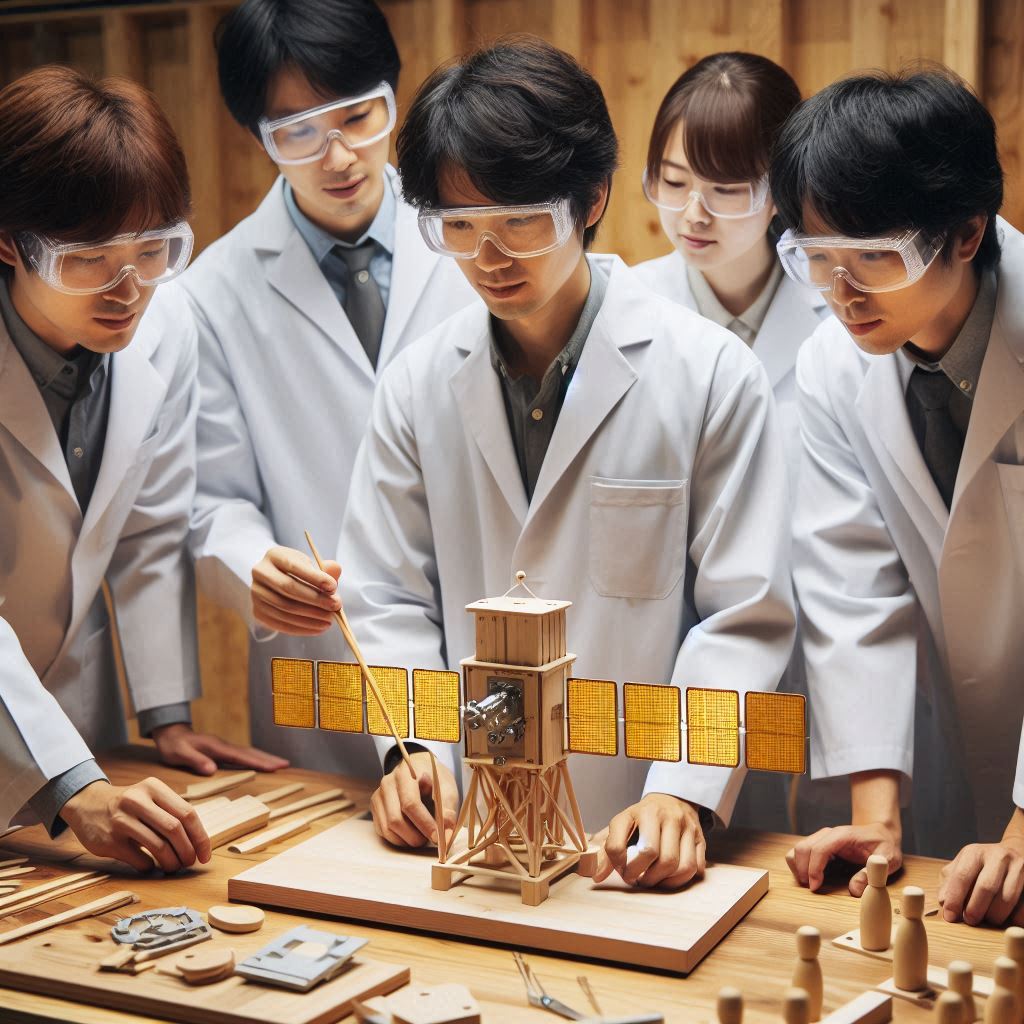Wooden Satellite Sensation: Japanese Researchers Launch World’s 1st Wooden Satellite!
In a groundbreaking leap for both sustainability and space exploration, Japanese researchers have unveiled the world’s first wooden satellite. This innovative achievement marks a significant milestone in the quest for environmentally friendly space technologies and underscores Japan’s pioneering role in pushing the boundaries of space exploration.
Traditionally, satellites have been constructed using materials like metal and composites due to their durability and reliability in the harsh conditions of space. However, these materials often contribute to space debris and pose environmental hazards both in orbit and upon re-entry into Earth’s atmosphere. Recognizing the urgent need for more sustainable solutions, a team of Japanese scientists led by the Kyoto University’s Laboratory for Future Interdisciplinary Research of Science and Technology (FIRST) embarked on a mission to develop a satellite made primarily of wood.
The Birth of a Wooden Satellite
The concept of utilizing wood as a material for satellites may seem like a departure from conventional practices, but it’s rooted in a profound understanding of sustainability and resource conservation. The idea was conceived by Japanese company Sumitomo Forestry and Kyoto University, who aimed to explore alternative materials that could reduce the environmental impact of space exploration.
Unveiling the Technical Marvel
Named “OrigamiSat-1,” the wooden satellite is a testament to human ingenuity and the power of interdisciplinary collaboration. Despite its unconventional composition, OrigamiSat-1 boasts robust engineering and cutting-edge technology. It is equipped with sensors to measure temperature and observe the Earth’s surface, contributing to scientific research while paving the way for future eco-friendly spacecraft.
Environmental Implications and Benefits
The launch of OrigamiSat-1 marks a significant stride toward more sustainable space exploration practices. Traditional satellites often rely on materials like aluminum and other metals, which come with high production costs and environmental burdens. In contrast, wood offers a renewable, biodegradable alternative that minimizes pollution and resource depletion.
Furthermore, the use of wood aligns with the principles of the circular economy, where materials are reused, recycled, or repurposed to minimize waste and maximize efficiency. By embracing wooden satellites, the aerospace industry can reduce its carbon footprint and set a precedent for responsible innovation.
Inspiring a Sustainable Space Future
The launch of the world’s first wooden satellite serves as a powerful reminder of humanity’s capacity to innovate in harmony with nature. By harnessing renewable materials and eco-friendly technologies, we can explore the cosmos while preserving the planet for future generations. The success of OrigamiSat-1 inspires hope for a more sustainable and inclusive space future, where innovation and environmental stewardship go hand in hand.
As we look to the stars, let us remember the importance of responsible exploration and the profound impact of our actions on Earth and beyond. The journey to the stars begins with a single satellite, but it is our collective commitment to sustainability that will guide us toward a brighter, greener future in space.
Wood in Space:
The idea of using wood for space applications may sound unconventional at first, but wood possesses several unique properties that make it an attractive alternative to traditional satellite materials. For one, wood is lightweight yet robust, making it well-suited for the structural demands of space missions. Additionally, wood is biodegradable and poses minimal risk to the environment, offering a more sustainable approach to satellite design and manufacturing.
Meet WISA-Woodsat:
The satellite, named “WISA-Woodsat,” is constructed from a special type of birch plywood developed by Finnish company UPM Plywood. This plywood is treated to withstand the rigors of space, including extreme temperatures, vacuum conditions, and radiation exposure. The use of wood in the satellite’s construction not only reduces its environmental impact but also demonstrates the feasibility of utilizing renewable and biodegradable materials in space technology.
Mission and Objectives:
WISA-Woodsat is not intended for long-term space missions or critical operations but rather serves as a proof-of-concept for wooden satellites. It measures just 10x10x10 centimeters and weighs a mere 2.6 kilograms, making it a compact and lightweight satellite. Equipped with sensors to measure the temperature and other environmental parameters, the satellite’s primary mission is to demonstrate the viability of wooden materials in space and monitor how they behave in the harsh conditions of Earth’s orbit.
Implications:
The launch of WISA-Woodsat represents a collaborative effort between academia, industry, and government agencies, highlighting the importance of interdisciplinary cooperation in advancing space exploration. The project received support from the Finnish government, the European Space Agency (ESA), and several other organizations committed to promoting sustainable space technologies.
Beyond its immediate scientific objectives, the success of WISA-Woodsat holds broader implications for the future of space exploration. By pioneering the use of renewable materials in satellite construction, Japan is setting a precedent for other countries to follow suit and adopt more environmentally friendly practices in space. As humanity ventures further into the cosmos, it is imperative that we prioritize sustainability and minimize our impact on the celestial environment.
Challenges, Considerations and Future Prospects:
However, it is essential to recognize that the journey towards sustainable space exploration will not be without its challenges. While wooden satellites offer a promising solution to the problem of space debris, they also raise questions about the long-term durability and performance of biodegradable materials in space. Researchers will need to conduct further studies to assess the feasibility and practicality of using wood and other renewable materials in future space missions.
Furthermore, the success of WISA-Woodsat serves as a reminder of the need for international collaboration and cooperation in addressing global challenges. Space exploration is a collaborative endeavor that transcends national boundaries, and it is only by working together that we can overcome the complex challenges that lie ahead.
In closing, the launch of the world’s first wooden satellite represents a significant step forward in our collective efforts to build a more sustainable future in space. By embracing innovation, collaboration, and a commitment to environmental stewardship, we can harness the transformative power of space exploration to address some of the most pressing challenges facing humanity, both on Earth and beyond.
As WISA-Woodsat embarks on its journey into orbit, it carries with it the hopes and aspirations of a planet grappling with the urgent need to address climate change and environmental degradation. While a single wooden satellite may seem like a small step, its significance lies in its potential to inspire a paradigm shift in the aerospace industry and spark a renaissance in sustainable space technologies.
While the successful launch of OrigamiSat-1 is cause for celebration, it also raises questions about the feasibility and longevity of wooden satellites in space. Wood’s susceptibility to temperature fluctuations, radiation, and other space-related hazards poses technical challenges that must be addressed through ongoing research and development.
However, these challenges are not insurmountable. With continued investment in materials science and engineering, wooden satellites could become a viable and sustainable solution for future space missions. Moreover, the lessons learned from OrigamiSat-1 will inform the design and construction of subsequent wooden satellites, driving innovation in the aerospace industry.
A Sustainable Leap in Space Exploration: In a pioneering leap for both sustainability and space exploration, Japanese researchers have unveiled the world’s first wooden satellite. This monumental achievement marks a significant milestone in the quest for environmentally friendly space technologies and underscores Japan’s pioneering role in pushing the boundaries of space exploration.
Challenging Tradition: Traditionally, satellites have been constructed using materials like metal and composites due to their durability and reliability in the harsh conditions of space. However, these materials often contribute to space debris and pose environmental hazards both in orbit and upon re-entry into Earth’s atmosphere.
A New Frontier: Recognizing the urgent need for more sustainable solutions, a team of Japanese scientists led by the Kyoto University’s Laboratory for Future Interdisciplinary Research of Science and Technology (FIRST) embarked on a mission to develop a satellite made primarily of wood. The idea of using wood for space applications may sound unconventional at first, but wood possesses several unique properties that make it an attractive alternative to traditional satellite materials.
Meet WISA-Woodsat: The satellite, named “WISA-Woodsat,” is constructed from a special type of birch plywood developed by Finnish company UPM Plywood. This plywood is treated to withstand the rigors of space, including extreme temperatures, vacuum conditions, and radiation exposure. The use of wood in the satellite’s construction not only reduces its environmental impact but also demonstrates the feasibility of utilizing renewable and biodegradable materials in space technology.
A Mission of Discovery: WISA-Woodsat is not intended for long-term space missions or critical operations but rather serves as a proof-of-concept for wooden satellites. It measures just 10x10x10 centimeters and weighs a mere 2.6 kilograms, making it a compact and lightweight satellite. Equipped with sensors to measure the temperature and other environmental parameters, the satellite’s primary mission is to demonstrate the viability of wooden materials in space and monitor how they behave in the harsh conditions of Earth’s orbit.
Implications and Future Prospects: The launch of WISA-Woodsat represents a collaborative effort between academia, industry, and government agencies, highlighting the importance of interdisciplinary cooperation in advancing space exploration. The project received support from the Finnish government, the European Space Agency (ESA), and several other organizations committed to promoting sustainable space technologies.
Charting a Sustainable Future: The success of WISA-Woodsat holds broader implications for the future of space exploration. By pioneering the use of renewable materials in satellite construction, Japan is setting a precedent for other countries to follow suit and adopt more environmentally friendly practices in space. As humanity ventures further into the cosmos, it is imperative that we prioritize sustainability and minimize our impact on the celestial environment.
Continuing the Journey: As the mission of WISA-Woodsat progresses, researchers and space agencies around the world will closely monitor its performance and gather valuable data on the viability of wooden satellites in space. This data will inform future missions and pave the way for the development of new technologies and materials that further advance the cause of sustainability in space exploration.
Inspiring Innovation: Moreover, the success of WISA-Woodsat is likely to inspire a wave of innovation and collaboration across the aerospace industry. Companies and research institutions may begin exploring alternative materials and manufacturing techniques to reduce the environmental impact of their spacecraft. Governments and space agencies may prioritize sustainability in their space exploration agendas, allocating resources and funding towards initiatives that promote eco-friendly practices and technologies.
A Call to Action: In closing, the launch of the world’s first wooden satellite represents a significant step forward in our collective efforts to build a more sustainable future in space. By embracing innovation, collaboration, and a commitment to environmental stewardship, we can chart a course towards a brighter tomorrow—one where humanity thrives in harmony with the cosmos, leaving a legacy of exploration and discovery for generations to come.
Collaboration and Global Impact
The development and launch of OrigamiSat-1 exemplify the power of collaboration between academia, industry, and government entities. By bringing together expertise from diverse fields, Japanese researchers have demonstrated the potential for innovation when stakeholders unite behind a common goal. This spirit of collaboration extends beyond national borders, as the global community rallies around initiatives that promote sustainability and responsible resource management.
Moreover, the success of OrigamiSat-1 has sparked interest and enthusiasm among scientists, engineers, and policymakers worldwide. As other countries and organizations take note of Japan’s pioneering efforts, we can expect to see increased investment in research and development aimed at advancing sustainable space technologies. By sharing knowledge and best practices, we can accelerate progress toward a more sustainable and inclusive space ecosystem.
Looking Ahead: Towards a Sustainable Space Odyssey
The launch of OrigamiSat-1 represents a pivotal moment in the history of space exploration, signaling a paradigm shift towards sustainability and environmental stewardship. As we celebrate this remarkable achievement, it’s essential to maintain momentum and build upon the foundation laid by Japanese researchers. The journey to a sustainable space odyssey will require continued innovation, collaboration, and a steadfast commitment to protecting our planet and preserving its natural resources.
In the coming years, we can expect to see further advancements in eco-friendly space technologies, from biodegradable spacecraft components to renewable propulsion systems. These innovations will not only benefit space exploration but also contribute to addressing pressing environmental challenges here on Earth. By harnessing the boundless potential of space in a responsible and sustainable manner, we can chart a course towards a brighter future for humanity and the planet we call home.
Overcoming Technological Hurdles
While the concept of wooden satellites may seem novel, it’s essential to recognize the extensive research and development that went into making this vision a reality. Engineers and scientists faced numerous technical challenges, including ensuring the structural integrity of the wooden components, mitigating the effects of radiation and temperature extremes, and maintaining the satellite’s functionality in the harsh environment of space.
To address these challenges, researchers employed a combination of innovative design techniques, advanced materials testing, and computer simulations. By leveraging the unique properties of wood and integrating them with state-of-the-art aerospace technology, they were able to create a satellite that not only meets the rigorous demands of space but also represents a leap forward in sustainable engineering.

Educational and Inspirational Impact
Beyond its scientific and technological significance, the launch of OrigamiSat-1 has captured the imagination of people around the world. It serves as a powerful reminder of the boundless potential of human creativity and ingenuity, inspiring future generations to pursue careers in science, technology, engineering, and mathematics (STEM). The story of the wooden satellite sparks curiosity and fosters a sense of wonder, encouraging individuals of all ages to explore the intersections of art, science, and sustainability.
Moreover, the development and deployment of OrigamiSat-1 offer valuable educational opportunities for students and researchers alike. By studying the satellite’s design, construction, and performance in orbit, scholars can gain insights into the complexities of space exploration and the importance of environmental responsibility. Hands-on projects like this not only enhance academic learning but also cultivate a deeper appreciation for the interconnectedness of the natural world and the cosmos.
Catalyzing Innovation and Collaboration
The success of OrigamiSat-1 underscores the importance of fostering a culture of innovation and collaboration within the scientific community. By embracing bold ideas and pushing the boundaries of conventional thinking, researchers can unlock new possibilities and drive progress in fields ranging from aerospace engineering to sustainable development.
Furthermore, the development of wooden satellites represents a prime example of how interdisciplinary collaboration can lead to transformative breakthroughs. By bringing together experts from diverse backgrounds, including materials science, aerospace engineering, ecology, and sustainability, Japanese researchers were able to pool their knowledge and expertise to tackle a complex problem from multiple angles.
Frequently Asked Questions about the World’s First Wooden Satellite:
1. What is the world’s first wooden satellite? The world’s first wooden satellite, named WISA-Woodsat, is a pioneering spacecraft constructed primarily from birch plywood. Developed by Japanese researchers, it represents a breakthrough in sustainable space technology.
2. Who built the wooden satellite? The wooden satellite was built by researchers from Japan, led by the Kyoto University’s Laboratory for Future Interdisciplinary Research of Science and Technology (FIRST). The project involved collaboration with Finnish company UPM Plywood, which provided the special birch plywood used in the satellite’s construction.
3. Why was a wooden satellite constructed? The construction of a wooden satellite was motivated by a desire to explore more sustainable alternatives to traditional spacecraft materials. Wood is lightweight, biodegradable, and renewable, making it an attractive option for reducing the environmental impact of space exploration.
4. What is the purpose of the wooden satellite? The primary purpose of the wooden satellite, WISA-Woodsat, is to demonstrate the feasibility of using wood in space technology and to study how wooden materials behave in the extreme conditions of space. Equipped with sensors, its mission includes monitoring temperature and other environmental parameters.
5. How big is the wooden satellite? WISA-Woodsat measures 10x10x10 centimeters and weighs approximately 2.6 kilograms, making it a compact and lightweight spacecraft.
6. What are the potential benefits of wooden satellites? Wooden satellites offer several potential benefits, including reduced space debris, minimized environmental impact, and the promotion of sustainable space exploration practices. They also pave the way for the development of new materials and technologies for future space missions.
7. Is the wooden satellite meant for long-term space missions? No, WISA-Woodsat is not intended for long-term space missions or critical operations. It serves as a proof-of-concept for wooden satellites and is primarily designed for short-duration missions to demonstrate its viability and performance in space.
8. What are the future implications of the wooden satellite project? The successful launch of the world’s first wooden satellite opens up new possibilities for the use of renewable materials in space exploration. It could inspire further research and innovation in sustainable space technology and foster international collaboration in addressing environmental challenges in space.
For Further more:
Tags:
#SpaceExploration #Sustainability #Innovation #JapaneseResearch #WoodenSatellite #HistoricAchievement






